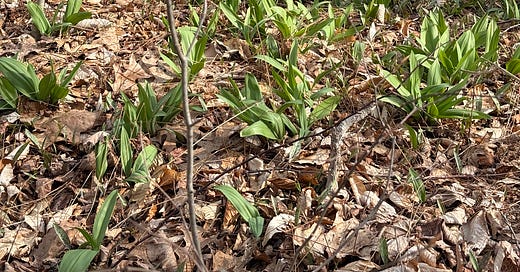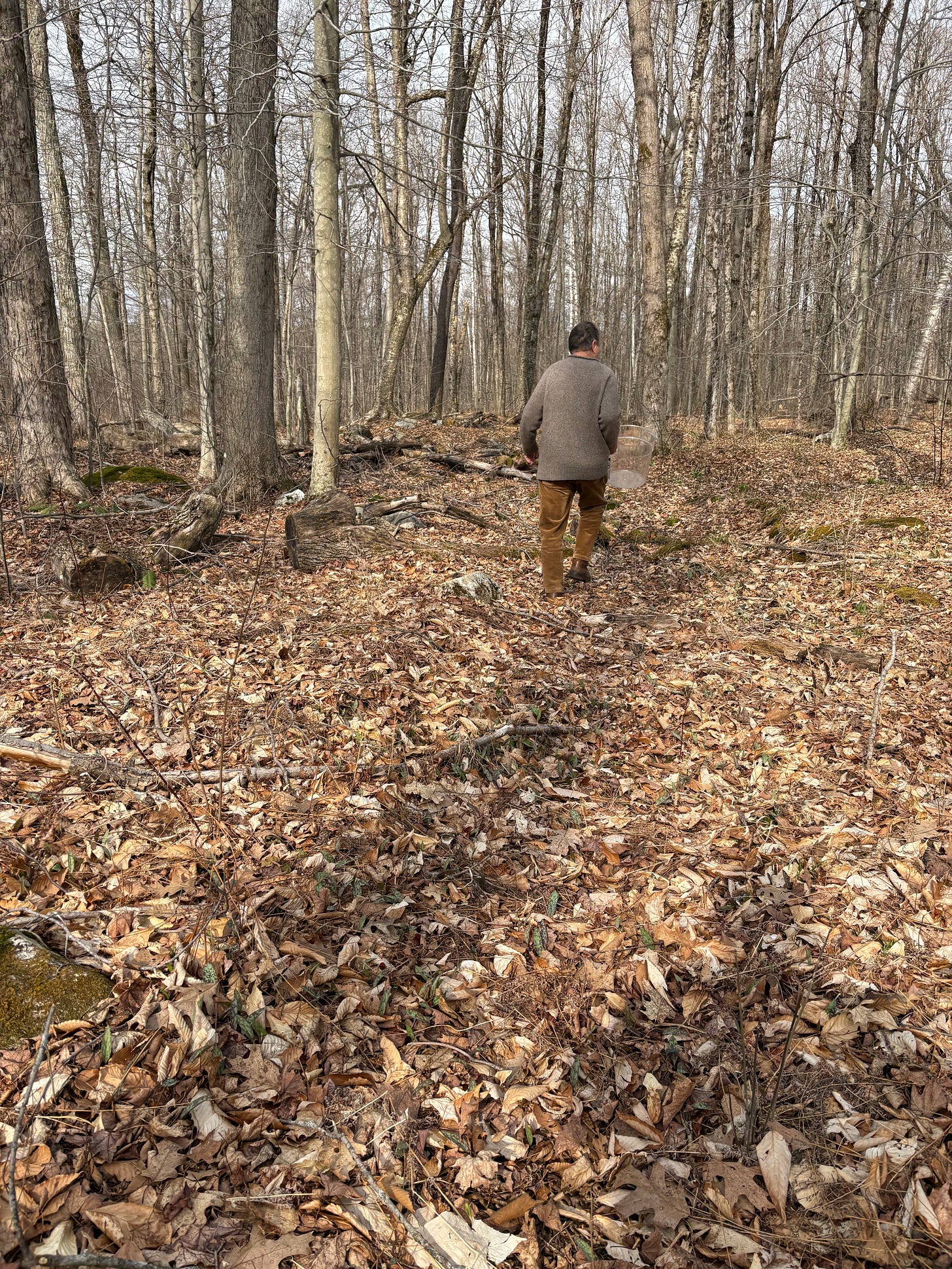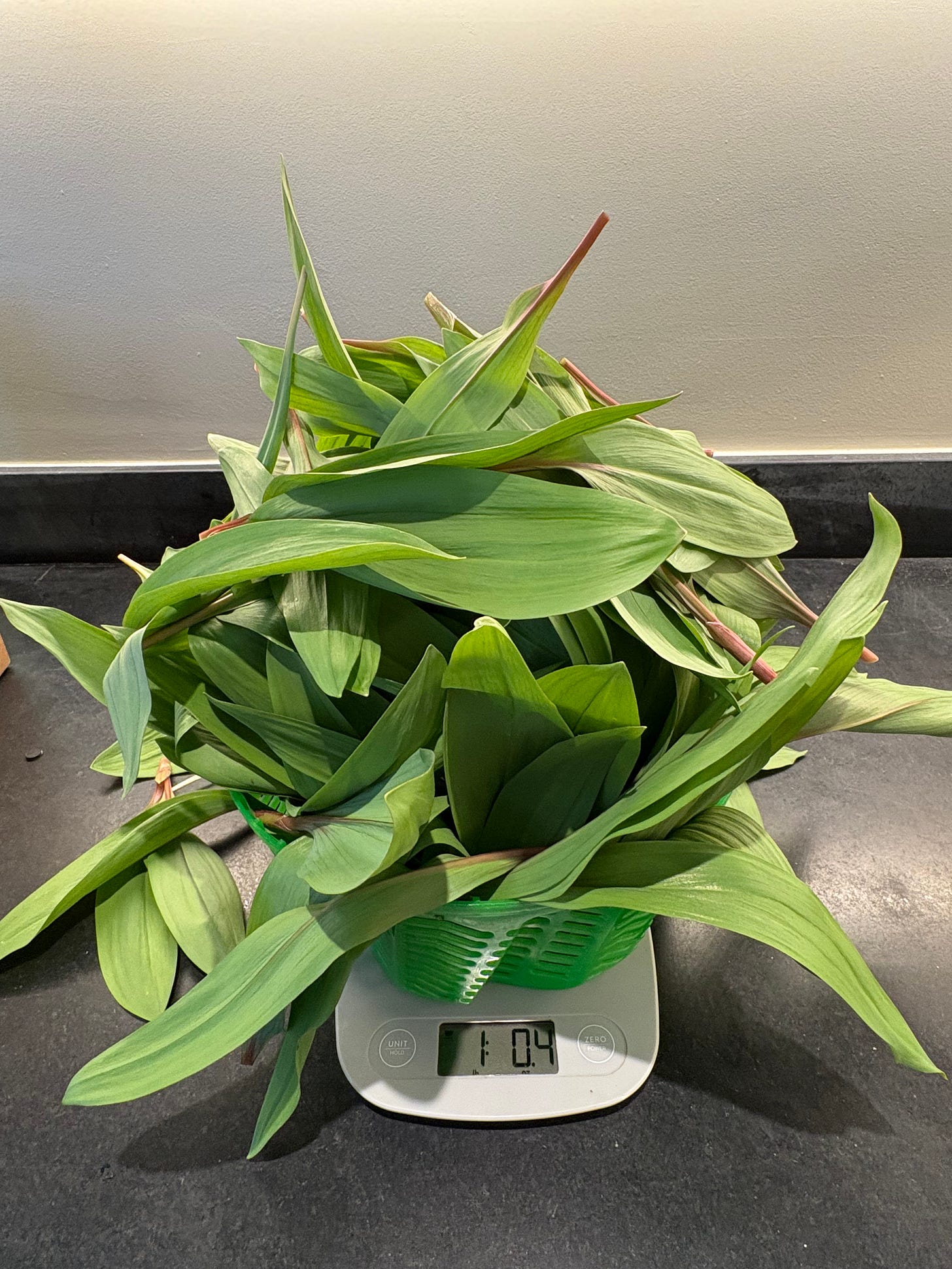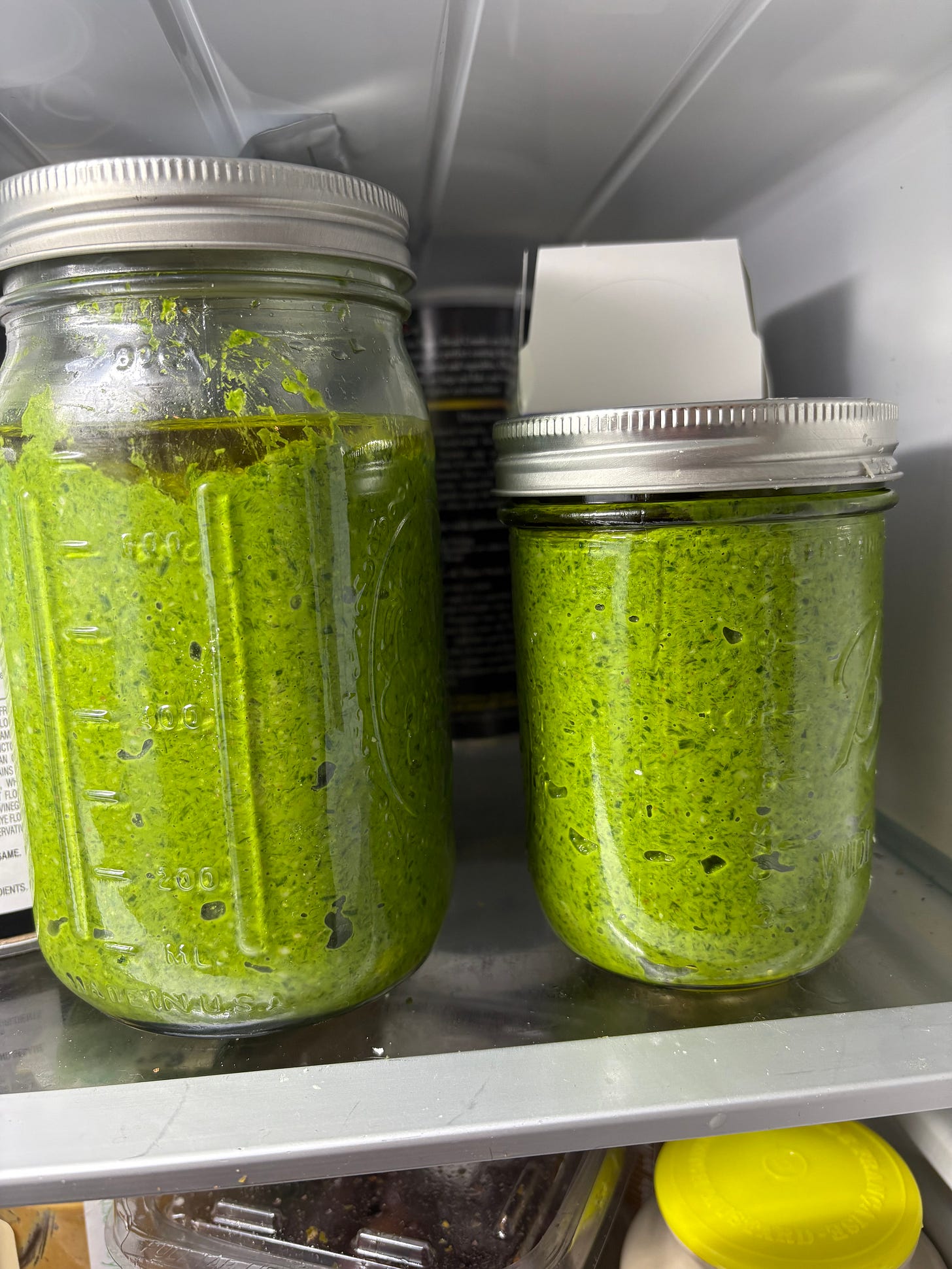I know where to find ramps, but can't tell you more
My neighbor took me on a long-promised expedition for these prized spring ephemerals that are a culinary treat
I wasn’t blindfolded or made to close my eyes and spin around three times. But I was sworn to secrecy: only family could be told the location of a ramp cornucopia that can be found (not that) deep into the woods in our town. The outing was two years in the making.
My neighbor, an excellent professional chef who learned the art of foraging in his native Germany, had been mentioning – somewhat cryptically – that some day I may be invited to accompany him on an expedition for ramps, the culinary treat that appears for only a few weeks each year in early spring. Finally, the day came.
We set out in two cars. Erhard led the way in his and me, along with another friend also on his first ramp harvest, followed in mine. After driving a few miles from our village we went up a dirt road, passed a small lake and parked. It was a sunny, mild morning, and the absence of leaves on the trees allowed ample light to illuminate the dark green leaves of the ramps that we could see about 20 yards away rising up from the forest floor.
As we made our way into the woods, the only sound was the crunch of crispy, dry fallen leaves that covered the ground and the song of early arriving warblers.
As we approached the spot, Erhard stopped to point out the difference between ramp leaves and those of the yellow trout lily that were cheerfully growing in the same area. In a few weeks the trout lilies will display their delicate lemon yellow flowers that ornament the eastern U.S. forest each spring. “Don’t pick those,” Erhard said. “They’ll make you sick.”
It’s pretty easy to tell them apart. Trout lily leaves are smaller, rounded and mottled with pale brownish-purple spots and much lighter in color. Ramps grow in sets of two or three taller, narrow pointed leaves atop pale purple stems with a small white bulb just underneath the soil. Both plants are considered a sign of healthy soil. They prefer to grow in rich, moist ground in the shade of larger trees. They often are found near water. The area we were in had numerous little streams and boggy patches.
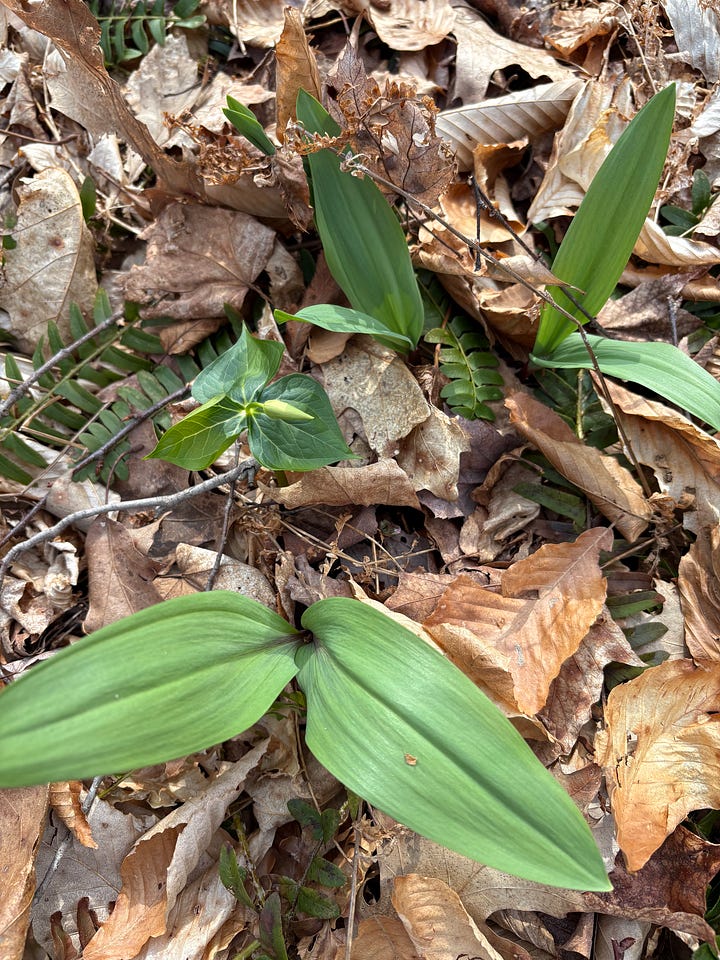

Erhard gave us a quick lesson in how to harvest the ramps. You can snip them with your fingers at ground level, he said, or use a knife to cut them. We didn’t dig up the bulbs, which many people do but it’s discouraged by some. The bulbs have a stronger flavor but many find the delicate flavor of the leaves preferable. They certainly do enough for me.
Over-harvesting is threatening ramps in parts of the Northeast so a certain etiquette comes with ramp foraging. Don’t dig them up or, if you do, leave at least a third of the ramps in place so the colony will survive and replenish itself. Take only what you intend to use.
And, it seems clear, don’t tell many people if you know of a good place to get them.
“Remember, only family,” our guide reminded us with his mischievous grin before heading off into the woods on his own toward … I’m not really sure what. Maybe a patch even more magnificent than the one we found ourselves standing in. “Bye!” he said as he walked off.
We met Erhard four years ago early in our first summer after buying our house in the Berkshires. We were out gardening when I noticed this figure coming through the woods, a mesh satchel over his back, down the steep hill on the eastern end of our land. He was a timeless vision. “Hello,” he said cheerfully with a wave. “I’m mushrooming on your property.”
We said that was no problem with us, and he offered us some of his harvest. We declined but in the months and years that followed we have gratefully accepted mushrooms from him, in addition to other delicacies he creates from food taken from the land.
It didn’t take too long before I was efficiently wielding my Swiss Army knife, grasping the ramp leaves in one hand and slicing through their delicate stems with the other. Their familiar smell filled my nostrils and embedded itself on the skin of my hands. It was sweet and earthy, faintly like garlic but also onions and chives.
Within 45 minutes I had filled a small bag. It seemed like this was more than enough. I said so to my companion and he agreed, so we made our way back to the car. We reminded ourselves that this was a pleasant way to start the day.
When I got back home I weighed the ramps. I had collected one and a half pounds, certainly a lot more than I had bought at the farmers market or Mill River General Store in past years. Over the next couple days, I made two batches each of ramp pesto and ramp butter that will more than tide us over in the months ahead.
Now that I know where to go, ramps will never be too far away each spring.
Here are Erhard’s recipes for making ramp pesto and ramp butter.
Ramp pesto
If you’ve made basil pesto, you can make ramp pesto. The recipes are basically the same. I filled the container of our food processor with ramp leaves (about 3-4 cups packed), turned it on and began slowly adding equal parts of extra virgin olive oil and sunflower oil until the leaves were blended to a smooth consistency. (I’ve always used only olive oil for pesto but Erhard thinks EVO on its own dominates the flavor too much, at least with ramps. So he softens it with sunflower or safflower oil; never canola oil.) I added salt to taste, about a half cup of ground up almonds and a similar amount of grated parmesan. Then I put the pesto in a glass canning jar and covered it with a thin layer of olive oil – a mirror of oil in culinary circles – to preserve everything. With the mirror on top, it’ll keep in the refrigerator for a year.
You can use ramp pesto the same way you would use pesto made from basil. We’ve baked a halibut steak with a couple tablespoons of ramp pesto and a few thinly sliced lemons on top and had ramp pesto pasta with grated parmesan cheese. I’m planning to make pizza soon with the ramp pesto drizzled on top. It’s great with chicken and steak as well, or as a garnish atop a burger.
Ramp butter
To make ramp butter, use the food processor to blend unsalted butter at room temperature and chopped ramps at a ratio of two parts butter to one part ramps. In each batch I used two sticks of butter, which weigh 230 grams, and 115 grams of chopped ramps. I had to keep shutting off the food processor to push the butter back down to the blade to get it to mix but after a little time it started blending well. If you’re having trouble getting it to blend, you can always add a small amount of sunflower oil. Add salt and continue blending. If you like, you can also add a little chopped parsley or chives or a small amount of lemon juice, though I didn’t. To store the ramp butter I didn’t put in the refrigerator I lined small ramekin-type cups with plastic wrap, packed them with the butter, folded the plastic wrap over the tops and froze them. When they had frozen I took the butter out of the cups and put it in plastic storage bags. It should keep in the freezer for several months.
So far we’ve had ramp butter smeared on toasted bread and bagels, mixed with pasta and a little parmesan cheese for a simple pasta dish and combined with oven-roasted fingerling potatoes. You can use it in place of butter for almost any dish if you’re up for a little added, but not overpowering, burst of flavor. It’s great with vegetables.
Here’s a selection of recent posts:

